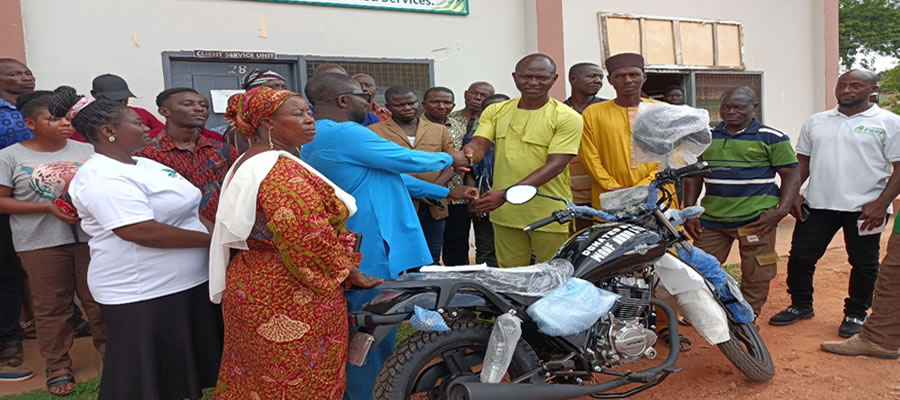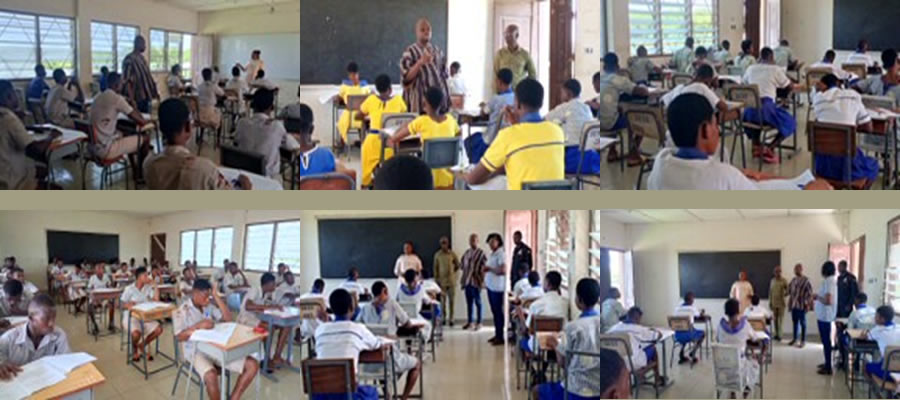

To increase production and productivity levels of the various sectors of the District Economy through enhanced economic infrastructure, private sector participation and competitiveness and diversification of economic activity and to ensure that all people in the District have access to basic social services such as health care, quality education, potable drinking water, decent housing and security from crime and ability to participate in decisions that affect their lives.
Goals and Objectives
Environmental Development
Goal
To provide a clean environment with minimum health risks to all citizens of the District
Objectives
- To reduce the incidence of bush fires in the District by at least 60% through education and the enforcement of anti-bushfire bye-laws.
- To prepare land use schemes for all communities ready for land use development plans
- To provide solid waste disposal sites for Jema, the District capital and two other bigger communities.
- To promote anti bush fire activities
Human Settlement Development.
Goal.
To provide the necessary infrastructure and services that will meet the needs of the needs of the increasing population.
Objectives
- To improve the quality of the road network through rehabilitation, regravelling, and reconstruction works.
- To extent electricity to communities that are ready for connection to the National grid especially those along the main high tension lines
- To provide potable water to at least 65% of the population and promote private sector participation in water provision.
Micro/District Economy
Goal
To ensure that the District is less dependent on Central Government for financial resources to carry out its development projects.
Objectives
- To improve upon the generation of Internally Generated Fund through prudent financial management.
- To promote the practice of linking financial disbursement to stated priorities, felt needs and laid down guidelines.
- To encourage civil society organisations to support in the financing of development projects in the District.
Private Sector Competitiveness
- To enhance investment climate and integrate the informal sector into mainstream District economy.
- To provide sufficient incentives to stimulate private sector activities through small Business Associations and cooperatives.
- To facilitate linkage between small business associations and the financial markets.
Human Resource Development and Basic Services.
Goal.
To improve human capital and the quality of life of the people in the District through increased access to quality education, health service, water and sanitation facilities.
Objectives
- To provide educational infrastructure and equip and supervise all basic schools to improve performance at that level.
- To support the training of teachers to ensure quality teaching and learning at the basic level.
- To support the training of nurses to ensure quality health delivery in the District.
- To intensify the education on the Mutual Health Assurance Scheme and encourage people to register and renew their registration with the scheme.
- To intensify the campaign against HIV/AIDS in the District.
- To encourage the provision of household toilet facilities.
Special Programmes for the Vulnerable and Excluded.
Goal.
To strengthen the collaboration and co-ordination of all departments that provide assistance to the vulnerable and excluded in society.
Objectives
- To strengthen the technical capacity of the departments of social welfare, and community development.
- Provide financial resources to the department to effectively meets the needs of the vulnerable and excluded.
Good Governance and Civic Responsibility
Goal.
To promote citizen participation in local decision making processes.
Objectives
- To develop the capacities of the Area Councils to function efficiently.
To enforce regulations, laws and public security.
Goals and Objectives
The Government of Ghana aims to attain middle income status (with per capita income of at least US$1000) by the year 2015 and the protection and empowerment of the vulnerable and excluded within a decentralised, democratic environment.
This goal will be achieved through:
- Continued macroeconomic stability
- Accelerated private sector-led growth
- Vigorous human resource development
- Good governance and civic responsibility
Development Projections for 2006-2009
This section deals with the important projections necessary for the estimation of the various services and facilities required during the planning period. Paramount among these is population projections on which all other projections revolves.
Population Projections
As part of the development planning process, population projection is very vital. This is because, the size and composition of the population varies overtime with corresponding changes in the number and level of social services and infrastructure requirement.
In view of this, the population of the Kintampo South District has been projected into the year 2009 for the purpose of the plan.
Due to the short period for which the plan will be in operation, the geometric method of population projection was adopted. An average Population growth rate of 3.0% is estimated for the District based on the population census figures of the 1970, 7984 and the 2000.
The following assumptions were made in projecting the population.
- The rate of migration into the District will be insignificant during the plan period
- The age composition of the population is not likely to change significantly.
- Child mortality rate in the District remains constant.
It can be deduced from the table above that, if the current factors for population growth in the District continue unchanged, in which case the growth rate of the population will not also change significantly, the total population of the District by the end of the plan period, 2009, will be 102,279.
Monitoring and Evaluation
This chapter of the District Medium Term Development Plan (2006 – 2009) outlines the institutional arrangements that will support and sustain effective Monitoring and Evaluation of the DMTDP at the district level. It defines roles and responsibilities of government agencies, officials and other stakeholders in accordance with the relevant legal provisions. It lays emphasis on the involvement of traditional authorities, Area Councils, Civil Society Organizations and development partners to create a holistic and participatory approach, effective feed back mechanisms and demand for Monitoring and Evaluation information.
Under its decentralized M&E institutional and reporting framework, NDPC has prepared guidelines for the preparation of District M&E Plan. The Kintampo South District Assembly is to use the guidelines to prepare a comprehensive M&E Plan and Budget under the GPRS II for Monitoring and Evaluation of the DMTDP.
Monitoring
Monitoring is a process, which ensures that, at any given stage of a project, the required inputs are delivered on time, used as intended and is producing the desired results.
To determine whether these results have been achieved, the causes of deviation, if any, and how to counteract any untended consequences, evaluation processes are undertaken. The main purpose for evaluation is to give feedback, which can lead to re-planning.
Since plans are affected by uncontrollable situations such as:
(i) Socioeconomic changes
(ii) Political climate
(iii) International relations
it is necessary that they are constantly monitored and adjustments made accordingly.
This monitoring scheme is designed for the annual plan. In the scheme, three (3) activities occur: -
- Monitoring activities cover the implementation period.
- On-going evaluation occurs at specific points within the implementation phase.
- Terminal evaluation occurs at specific end of the project implementation.
District Level Monitoring and Evaluation
At the district level, the activities of Monitoring and evaluation are responsibilities of the District Planning Coordinating Unit (DPCU). Section 46, sub-section 3 of the Local Government Act, 1993, Act 462 establishes the DPCU to assist the District Assembly to execute designated planning functions. The National Development Planning (Systems) Act, 1994, Act 480 defines the DPCU’s planning, M&E and coordinating functions.
The DPCU is responsible specifically for the preparation of monitoring and evaluation procedures as well as the monitoring and evaluation plan, using NDPC guidelines. Again, it is required to provide oversight over all District level monitoring and evaluation of projects and also carry out the monitoring and evaluation of district development policies. Actual project monitoring and evaluation are, however, the responsibility of the district sectoral developments. Assistance would be obtained from the community, Governmental and Non-governmental organizations.
Evaluation
Evaluation is conducted in greater detail at the project level. mid-term evaluation is conducted in order to find out whether the resources invested have produced or are producing the expected level of output and benefits and whether the benefits are reaching the intended target population. The first mid-term ex-post facto evaluation should be conducted one year after completion of the project when the impact of the project should be evident.
The DPCU and other stakeholders will conduct Mid-Term and terminal evaluations of the DMTDP. The performance of all projects will also be evaluated when completed to assess its performance and ascertain if the intervention has achieved its original objectives. It will also assess the overall changes caused by the intervention or project. The evaluations will be used as management tool to improve upon programme design and implementation.
The DPCU at relevant time will also undertake or commission other studies such as:
• Strategic Evaluation
• Impact Assessments (Economic, social and Environmental)
• District Poverty Profiling and Mapping
• Thematic Evaluation Studies
• Beneficiary Assessments
The DPCU will educate and create and accommodate any future changes, which may occur, or events, which were unforeseen during the plan preparation process. There is therefore the need to update components of the plan on an annual basis. It must, however, be emphasized that the Assembly has the responsibility of ensuring that there is very little, if any, deviation from provisions and proposals made in the plan during implementation.
This is one way of making a more efficient use of the Assembly’s resources while ensuring that a solid foundation is laid for the achievement of the District’s long-term development objectives. It will therefore be essential to ensure that for each year of the three (3) – year MTDP, projects to be implemented are adequately reflected in the Assembly’s budget.
It is expected that the DPCU will be supported to play a crucial and very important role in the performance of the awareness among beneficiaries and to involve them in the selection of indicators to monitor. To ensure participatory M&E, the DPCU will promote partnership between the District Assembly, NGOs/CBOs and communities.
To supplement this effort at the District level, the National Development Planning Commission (NDPC) and the Regional Planning Coordinating Unit (RPCU) shall provide a general overview of the monitoring and evaluation activities. The Assembly is to support the DPCU to draw its M&E Plan to carry out M&E effectively.
Programmes and Projects
Based on the presentation of the broad goals and objectives for the thematic areas of GPRSII, the rest of the chapter details out the programmes and projects for implementation within the next four years.
Project Selection Criteria
The selection of projects for implementation in this plan was informed by a number of factors. Most important among these is the Government’s medium Term programme spelt out in the Growth and poverty reduction strategy (GPRSII). Indeed the three major thematic areas were considered in the selection and projects under these themes have been given priority.
Secondly, local or community priorities were given a serious consideration in the prioritisation of projects. At a public hearing with a cross section of the population, the highly prioritised areas were Education, Health, Transportation, Environment, Water and Sanitation.
Other factors that were considered in the selection process include the following:
- Potential of projects in contributing to employment and income generation.
- Cost effeteness of the project.
- The level of linkage of a project with other projects and multiplier effects.
Finally, the time frame within which the plan is to be executed was considered in the total number of projects taken on board.
The plan considers a numbers of areas for intervention but has in focus the following as key priorities of the people.
• Education
• Health
• Roads/Transportation
• Environment
• Water and sanitation
Projects for Private Sector Competitiveness
Agriculture
1. Improving and provision of irrigation facilities in the District.
2. Enhancing access to agriculture inputs
3. Increasing access to extension services
4. Enhancing access to credit.
5. Improving storage and reducing post harvest losses.
6. Improving access to and availability of farm lands
7. Restoration of degraded environment
Promoting Trade and Industry
The underlying strategy of this framework is to develop an agro-based industrial economy based on the GPRSII. The following are the major priority areas for intervention:
- Increasing Agro-processing
- Provide skills for entrepreneurial training for SSEs, the unemployed etc.
- Promote training of people with disabilities
Micro-Economy
- Minimize revenue leakages
- Review and Revise existing taxes, rates, fees and user charges.
- Strengthen the capacities of revenue collecting Team
- Increase revenue generation in the district
Roads and Transportation
To improve physical accessibility to socio-economic facilities
Ensure the provision, expansion and maintenance of transport infrastructure in the District
1. Improve road maintenance.
2. Rehabilitation of farm to market roads.
3. Construction of culverts
Energy
Objective:
To increase access to electricity.
Strategies
Extension of electricity to; Cherehin, Nante, Amoma, Anyima, Kokuma, Ntankro, etc.
Objectives:
1. To promote tourism in the District by 2009
2. To develop potential tourism sites.
Human Resource Development
Development of the human resources of the district and for that matter the country is one of the three key pillars of the GPRSII.
The overall goal of this sector as stated above involves the provision of educational infrastructure, improving access to basic social services such as health care, safe drinking water, and sanitation that improves the well being of the people.
Education
- Increasing access to quality education in the District.
- Improve the quality and quantity of school infrastructure at the basic level.
- Improve teachers’ residential accommodation in the District.
- Provide/establish incentives/scholarship schemes to increase girls enrolment, retention and completion of full cycle of education.
- Sensitize parents and communities on the importance of girls education
- Upgrading the only Senior Secondary School at Jema to a boarding status.
- Encourage students to undertake Technical and Vocational programmes.
- Establish an incentive scheme for Teachers who accept postings to deprived communities/areas (Teacher retention schemes established)
- Institutionalize a scholarship scheme for Teacher trainees who are into science and ICT.
Health
The main constraining factors affecting access to quality health care delivery include:
1. Geographical (poor physical access e.g. poor road network)
2. Financial barriers
3. Poor Service delivery and
4. Socio-cultural
Date Created : 11/17/2017 1:39:39 AM











 facebook
facebook
 twitter
twitter
 Youtube
Youtube
 +233 593 831 280
+233 593 831 280 0800 430 430
0800 430 430 GPS: GE-231-4383
GPS: GE-231-4383 info@ghanadistricts.com
info@ghanadistricts.com Box GP1044, Accra, Ghana
Box GP1044, Accra, Ghana